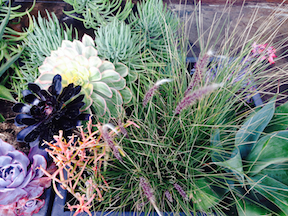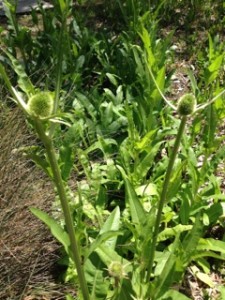I Can See Clearly Now The Rain Has Gone
âDo I dare disturb the universe?â The Love Ballad of Alfred J. Prufroc
Scientists have speculated the possible return of El Nino in 2015. Even if the storms do return, the forecast predicts only moderate precipitation for Northern California. Fortunately enough rainfall in April greened the golden hills, yet as we approach summer, we must be extra diligent in our conservation methods. The fire danger is enhanced because of our dry winter. In fact, the fire season of 2013 was still in progress as we entered the beginning of the 2014 fire season this month. As humans we have altered the climate and stressed our great globe. Itâs not too late to begin being better stewards. In my past two Digging Deeps, Iâve outlined how we can prepare our garden for the forthcoming drought. This is the third installment of the Drought Gardening Series with a list of plants that can thrive with little water.
If you missed Part 1 and 2, you can find them on-line at Lamorinda Weekly at these links:
Part 1: Singing in the Rain-Â https://www.lamorindaweekly.com/archive/issue0801/Digging-Deep-Gardening-with-Cynthia-Brian-Singing-in-the-Rain.html
Part 2: donât Doubt the Drought-https://www.lamorindaweekly.com/archive/issue0803/Digging-Deep-Gardening-with-Cynthia-Brian-Dont-Doubt-the-Drought.html
Â
Part 3-Drought Gardening Series
Drought Tolerant Plants from Goddess Gardener, Cynthia Brian
Enriched, compost amended soil is the most important foundation element to growing any garden. Apply three inches of mulch to maximize water savings, maintain moisture, reduce run-off, and shield the soil from direct sunlight. Group plants with similar water needs together, stop fertilizing, eliminate weeds, deadhead before seed pods form, build wind barriers, create shade, and water appropriately, infrequently, yet deeply. Choose a sampling of these drought resistant, low maintenance specimens.
Annuals                                                         Shrubs                                                           Vegetables
Amaranthus                                                    Abelia                                                              Armenian Cucumber
Cosmos                                                           Holly                                                               Artichoke
Cleome                                                            Hibiscus                                                          Bean
Dusty Miller                                                   Hydrangea                                                       Beet
Lupine                                                             Palm                                                                Corn
Marigolds                                                        Nandina                                                           Chile
Poppy                                                             Oleander                                                          Eggplant
Portulaca                                                         Pomegranate                                                    GarlicÂ
Verbena                                                           Viburnum                                                        Lettuce                                                                                                                                                                                    Mustard
Perennials                                                     Herbs                                                              Onion
Agastache                                                        Anise                                                               Pea
Bush Sage                                                        Bay                                                                 Peppers
Blanket flower                         Catmint                                                           Radish
Cactus                                                             Catnip                                                             Rhubarb
Currant                                                            Chives                                                             Spinach
Daylily                               Dill                                                                  Squash
Echinacea                                                        Fennel                                                             Swiss Chard
Fern                                                                 Feverfew                                                         Tomato
Geranium                                                        Lemongrass                                                     Turnip
Ginger                                                             Marjoram                                                        Zucchini
Helleborus                                                       Oregano
Ice Plant                                                          Parsley                                                                  Grasses
Lambâs Ear                                          `           Purslane                                                          Blue Oatgrass
Lamium                                                           Rosemary                                                        Fountain Grass
Lavender                                                         Sage                                                                 Japanese Bloodgrass
Russian Sage                                                   Spearmint                                                        Leatherleaf Sedge
Sedum                                                             Savory                                                             Maiden Grass
Succulents                                                       Stinging Nettle                                                Pampas Grass
Yarrow                                                            Thyme                                Reed Grass
Yucca                                                              Wild Garlic                                                      Zebra Grass
Â
This is not a complete list of plants that will grow with minimal moisture and maintenance. Talk to your nursery professional for more advice and local recommendations. Visit garden centers to see the specimens that will work best with your landscaping requirements. Remember that all plants need water. Natives, succulents, and cacti fare the best in dry conditions and may add beauty and texture to your existing garden with less care. Bulbs are always excellent choices providing perennial color, form, and fragrance. Consider xeriscaping as it conserves 50-75% of water utilizing creative landscaping techniques.
Until next time, remember that to build a better future we must nurture nature. We are blessed to live on planet Earth. Care for the land and all of God’s creatures and will reap the benefits. Never forget that love always wins when kindness prevails, plus gardens make us happy. Read a book in May-it’s a garden in bloom. Stroll through the garden to actually smell the roses! They are glorious this year.
Happy Gardening! Happy Growing!
Cynthia Brianâs Mid Month Reminders
ü  PLANT flowers in drifts of several colors to enable bees and butterflies to see them better.
ü  CREATE a wide defensible space perimeter around your home to protect your family from fires.
ü  CONTINUE succession planting of beets, carrots, turnips, radishes, and other root edibles for uninterrupted harvests all season.
ü  COLD hardy peonies are popping up creating waves of color in the garden. Peonies make sophisticated floral arrangements.
ü  PULL weeds that are zapping your water, especially teasel rosette. This roadside weed is a biennial and quite prickly to touch. Nonetheless, many people use the dried flower heads in arrangements because of their interesting shape and size (they can grow up to 2m tall!). This widely adapted plant is native to Eurasia.
ü  EAT the pea like flowers of the fava bean plant as well as the leaves. Fava leaves are nutty tasting while the flowers have a mildly sweet flavor akin to spring peas.
Â
©2014
Cynthia Brian
The Goddess Gardener
Starstyle® Productions, llc
http://www.GoddessGardener.com
Cynthia is available as a speaker and consultant. Listen to her radio show on the Voice America Empowerment Network Wednesdays 4-5pm PT LIVE or visit http://www.StarStyleRadio.com








